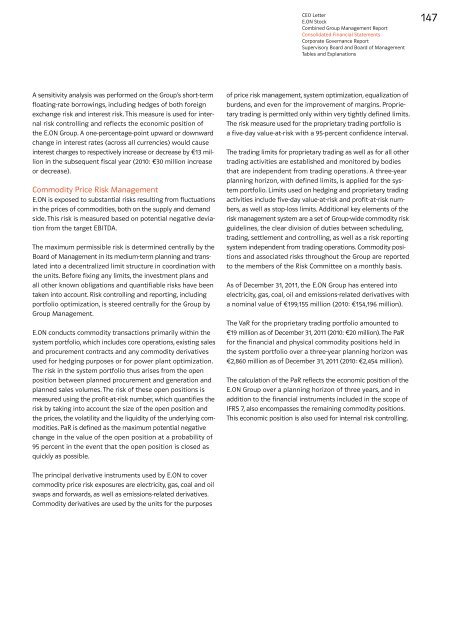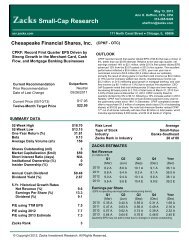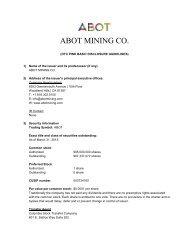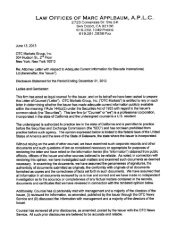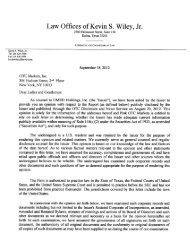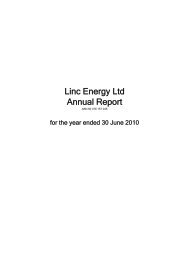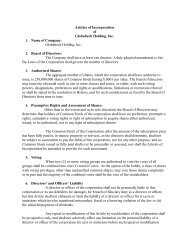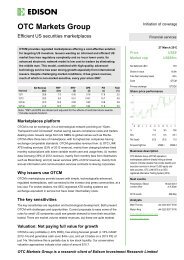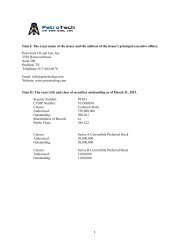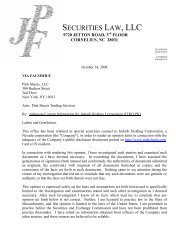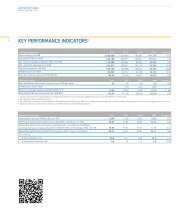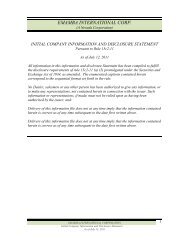2011 Annual Report - OTCIQ.com
2011 Annual Report - OTCIQ.com
2011 Annual Report - OTCIQ.com
Create successful ePaper yourself
Turn your PDF publications into a flip-book with our unique Google optimized e-Paper software.
A sensitivity analysis was performed on the Group’s short-term<br />
floating-rate borrowings, including hedges of both foreign<br />
exchange risk and interest risk. This measure is used for internal<br />
risk controlling and reflects the economic position of<br />
the E.ON Group. A one-percentage-point upward or downward<br />
change in interest rates (across all currencies) would cause<br />
interest charges to respectively increase or decrease by €13 million<br />
in the subsequent fiscal year (2010: €30 million increase<br />
or decrease).<br />
Commodity Price Risk Management<br />
E.ON is exposed to substantial risks resulting from fluctuations<br />
in the prices of <strong>com</strong>modities, both on the supply and demand<br />
side. This risk is measured based on potential negative deviation<br />
from the target EBITDA.<br />
The maximum permissible risk is determined centrally by the<br />
Board of Management in its medium-term planning and translated<br />
into a decentralized limit structure in coordination with<br />
the units. Before fixing any limits, the investment plans and<br />
all other known obligations and quantifiable risks have been<br />
taken into account. Risk controlling and reporting, including<br />
portfolio optimization, is steered centrally for the Group by<br />
Group Management.<br />
E.ON conducts <strong>com</strong>modity transactions primarily within the<br />
system portfolio, which includes core operations, existing sales<br />
and procurement contracts and any <strong>com</strong>modity derivatives<br />
used for hedging purposes or for power plant optimi zation.<br />
The risk in the system portfolio thus arises from the open<br />
position between planned procurement and generation and<br />
planned sales volumes. The risk of these open positions is<br />
measured using the profit-at-risk number, which quantifies the<br />
risk by taking into account the size of the open position and<br />
the prices, the volatility and the liquidity of the under lying <strong>com</strong>modities.<br />
PaR is defined as the maximum potential negative<br />
change in the value of the open position at a probability of<br />
95 percent in the event that the open position is closed as<br />
quickly as possible.<br />
The principal derivative instruments used by E.ON to cover<br />
<strong>com</strong>modity price risk exposures are electricity, gas, coal and oil<br />
swaps and forwards, as well as emissions-related derivatives.<br />
Commodity derivatives are used by the units for the purposes<br />
CEO Letter<br />
E.ON Stock<br />
Combined Group Management <strong>Report</strong><br />
Consolidated Financial Statements<br />
Corporate Governance <strong>Report</strong><br />
Supervisory Board and Board of Management<br />
Tables and Explanations<br />
of price risk management, system optimization, equalization of<br />
burdens, and even for the improvement of margins. Proprietary<br />
trading is permitted only within very tightly defined limits.<br />
The risk measure used for the proprietary trading portfolio is<br />
a five-day value-at-risk with a 95- percent confidence interval.<br />
The trading limits for proprietary trading as well as for all other<br />
trading activities are established and monitored by bodies<br />
that are independent from trading operations. A three-year<br />
planning horizon, with defined limits, is applied for the system<br />
portfolio. Limits used on hedging and proprietary trading<br />
activities include five-day value-at-risk and profit-at-risk numbers,<br />
as well as stop-loss limits. Additional key elements of the<br />
risk management system are a set of Group-wide <strong>com</strong>modity risk<br />
guidelines, the clear division of duties between scheduling,<br />
trading, settlement and controlling, as well as a risk reporting<br />
system independent from trading operations. Commodity positions<br />
and associated risks throughout the Group are reported<br />
to the members of the Risk Committee on a monthly basis.<br />
As of December 31, <strong>2011</strong>, the E.ON Group has entered into<br />
electricity, gas, coal, oil and emissions-related derivatives with<br />
a nominal value of €199,155 million (2010: €154,196 million).<br />
The VaR for the proprietary trading portfolio amounted to<br />
€19 million as of December 31, <strong>2011</strong> (2010: €20 million). The PaR<br />
for the financial and physical <strong>com</strong>modity positions held in<br />
the system portfolio over a three-year planning horizon was<br />
€2,860 million as of December 31, <strong>2011</strong> (2010: €2,454 million).<br />
The calculation of the PaR reflects the economic position of the<br />
E.ON Group over a planning horizon of three years, and in<br />
addition to the financial instruments included in the scope of<br />
IFRS 7, also en<strong>com</strong>passes the remaining <strong>com</strong>modity positions.<br />
This economic position is also used for internal risk controlling.<br />
147


